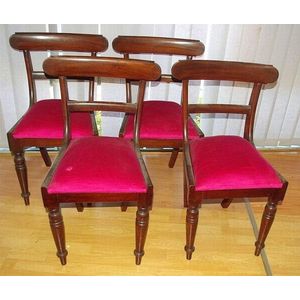Regency Chairs with Leather Seats and Turned Legs
Pair of Regency chairs, with curved back above reeded supports above a brown leather over covered seat with studded border, on turned legs (2)
You must be a subscriber, and be logged in to view price and dealer details.
Subscribe Now to view actual auction price for this item
When you subscribe, you have the option of setting the currency in which to display prices to $Au, $US, $NZ or Stg.
This item has been sold, and the description, image and price are for reference purposes only.
- Regency Period - The Regency period in English furniture design refers to the period when King George III, was declared unfit to rule in 1811, and his son ruled as proxy as Prince Regent, until 1820, and then, after the death of his father as George IV until his death in 1830. The Regency period was preceded by the Georgian period (George I, George II, and George III: 1714 - 1811), and was followed by the William IV period, which only lasted until 1837 when William IV died as was succeeded by Queen Victoria.
- Turned Legs - are legs which have been turned on a lathe. In use from the 16th century, turned legs on tables, chairs and cabinets became more frequent until, by the 1830s, the Georgian square or tapered leg was rarely found except in country pieces.
- Turning - Any part of a piece of furniture that has been turned and shaped with chisels on a lathe. Turned sections include legs, columns, feet, finials, pedestals, stretchers, spindles etc. There have been many varieties and fashions over the centuries: baluster, melon, barley-sugar, bobbin, cotton-reel, rope-twist, and so on. Split turning implies a turned section that has been cut in half lengthwise and applied to a cabinet front as a false decorative support.
- Reeding - A series of parallel, raised convex mouldings or bands, in section resembling a series of the letter 'm'. The opposite form of fluting, with which it is sometimes combined. Reeding is commonly found on chair legs, either turned or straight, on the arms and backs of chairs and couches and around table edges in the Neoclassical or Classical Revival manner. Reeding was also used as a form of decoration during the Edwardian period, but it is usually much shallower and evidently machine made.
This item has been included into following indexes:
Visually similar items

A pair Victorian mahogany, upholstered rail back side chairs mid 19th century. Height 88 cm
Sold by
in
for
You can display prices in $Au, $US, $NZ or Stg.

A pair of neoclassical ebonised fruitwood armchairs, Northern Italian, circa 1820
Sold by
in
for
You can display prices in $Au, $US, $NZ or Stg.

Two Chinese hardwood Qing style armchairs carved scroll and floral form supports. Stretcher base
Sold by
in
for
You can display prices in $Au, $US, $NZ or Stg.

Set of four antique cedar rail back chairs
Sold by
in
for
You can display prices in $Au, $US, $NZ or Stg.
